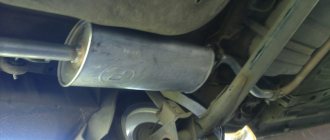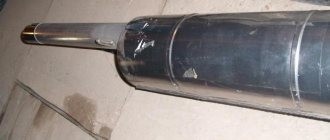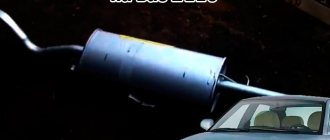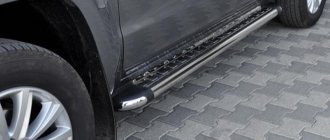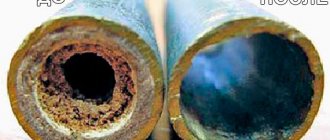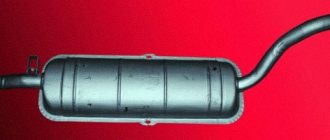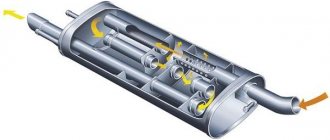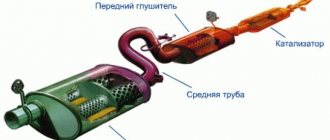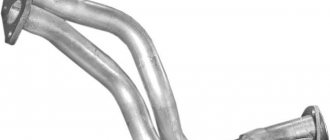The muffler becomes faulty at the most unexpected moment. Of course, this rule only applies to older cars. And especially those that are parked in open parking lots, rather than parked in a garage or underground parking lot. You can go to the service center (the fault allows), where the part that has become unusable will be replaced with a new one. But you can restore normal operation of the exhaust system with your own hands. To do this, you need to independently identify the faulty section of the muffler and repair it. And this can be done without resorting to welding.
DIY muffler repair without welding
In such a development of events, of course, it is necessary to repair the car, but this does not mean at all that you will have to print out an emergency supply of money that has been accumulated for a long time or take out a ruinous bank loan.
It is enough to spend a little time and effort - and the through hole can be eliminated with little means and with your own hands, and without the use of a welding machine.
After a well-carried out repair in a personal garage, the muffler will faithfully work for many more years, and with purely summer use of the car - up to five years.
Types of cold welding
The choice of this material should be approached carefully, since cold welding comes in several types, among which only the following are suitable for car repairs:
- Liquid formulations. Usually sold in special syringes and also available in packages where they are mixed automatically. Such liquid welding is most convenient to use, but after application the composition hardens “tightly” and cannot be mechanically corrected.
- Plasticine-like compositions. Such welding can be one-component or two-component. The first interacts with air, resulting in a chemical reaction that activates the material. Two-component welding reacts with compounds.
Also, materials differ depending on their manufacturer. For the muffler, it is best to choose welding:
- Abro Steel (USA). Which has excellent characteristics and high reliability.
- Titan (Russia). It is not inferior, and in some parameters even surpasses its American counterpart.
To repair a muffler with any of these compounds you won’t have to put in a lot of effort.
Recommendations from the master
Not so long ago, the happy owners of Zhiguli and Moskvich cars, who today seem to be true Kulibins, knew and used a wide range of quite effective methods for restoring the performance of the muffler.
Due to the fact that in those days it was almost impossible to get its new analogue due to the shortage and considerable cost, Soviet car enthusiasts used the following methods:
- Installation of various types of iron hoops;
- Filling with cement and clay fillings that are resistant to strong heat;
- Wrapping with fiberglass;
- Preventive making of grooves to remove condensate;
- Coating the muffler with moisture-repellent chemical compounds created somewhere in closed military-industrial complex laboratories.
Properties and selection.
Thermal tape is a strip of textile made from fibers with high thermal resistance.
Initially, the main material was asbestos. After its use was banned (asbestos fibers released into the air pose a serious threat to health), the tape began to be produced on the basis of other heat-resistant substances. Today, products are made using silica threads and graphite-based compounds. The former have higher operating temperatures.
New technologies make it possible to produce threads based on ceramics, carbon, expanded clay, and basalt. Methods are used to deposit particles of molten mineral components on the fibers (LR technology), resulting in a durable fabric that is resistant to extremely high temperatures and does not contain substances harmful to the environment and human health.
When choosing, several characteristics are taken into account:
- Limit temperature. The vast majority of materials are designed to withstand temperatures of 800-1100 degrees without loss of properties. Such tapes are suitable for thermal insulation of manifolds of non-turbocharged engines, windings of car mufflers, and tuning of motorcycle exhaust systems. Turbo units require limits of 1500 degrees and above, which are also provided by some products in the manufacturers' range.
- The width of the line. The material is supplied in rolls with a width of 25 mm and a length of 2 m or more. The choice is determined by the convenience of winding. The exhaust manifold is wrapped with a 25mm wide tape; for tuning motorcycle mufflers, a 50mm strip is more convenient.
Color. Recently, the nomenclature consisted of white, black and bronze ribbons. Now the range of manufacturers has been significantly expanded, which allows motorcycle owners to choose a solution that exactly matches the color scheme of the bike.
There is a wide selection of tape from several manufacturers on the market:
Thermo-Tec. The company's products are the most widely known and include the widest possible range of offerings. The materials are produced using advanced technologies, are of high quality and wear resistance (service life is about 3 years). The price starts from 25-30 US dollars.
- Nova is a company that produces automotive equipment and materials. Products of acceptable quality have an attractive price (average cost is about $20).
- Aster. It produces films of good quality, but inferior in the main indicators to the products of the leaders. The main advantage is low cost, practically not exceeding 1000-1500 rubles.
Video with recommendations for choosing.
Is it worth repairing the muffler yourself?
Currently, car mufflers and the components necessary for their operation can be purchased without even leaving home. There is no longer any shortage of such spare parts on the market, but they are still not cheap at all.
What is thermal tape for a muffler?
It should be noted that she came to us from the construction industry. Previously, it was heat-resistant asbestos fabric that could withstand temperatures of 1100 - 1500 degrees. However, as studies have shown, asbestos is very harmful to the environment and people nearby. Therefore, such fabrics are practically not used now (unless you order from China).
Now “tapes” for tuning are mainly made using silica threads or other silicon (graphite) compounds. Other manufacturers say that they make them almost from pulverized lava (LR technology), which melts and settles in the fibers, making the fabric very strong and stable. All types of threads (as well as asbestos) can withstand high temperatures, without any harm to the environment and humans.
Usually the thermal tape is about 5 centimeters wide and has a black color; if you run your hands over it, a black mark remains, like graphite.
Wide selection of modern auto sealants
Naturally, any prudent and economical car enthusiast will not rush to spend his hard-earned savings on buying a new unit just because of a few almost invisible fistulas found on the “original” muffler.
To successfully and permanently seal defects in the exhaust pipe without resorting to a labor-intensive welding procedure, you no longer have to look for or invent some clever method.
It is enough to use advanced devices produced today specifically for such repairs. Modern auto sealants allow you to quickly and efficiently eliminate holes of any diameter and cracks of any length.
Adding power
The power here is in the form of an error, namely you can count on +3+4% (maximum)!!! Of course, if you have a properly tuned exhaust + install this tape, then it will be quite good, plus the sound will be deep.
BUT you shouldn’t hope that the increase will be +5+10%; I’ll emphasize once again - as practice shows, the MAXIMUM is 3 percent (I admit 4, no more)
If you just installed the SPIDER and wrapped it with this thermoelement (did not remove the catalyst and did not replace the resonators), then the increase may not be noticeable at all.
Now we are watching the video version.
This is where I end, I think my article was useful and interesting to you. Subscribe to our channel and website, there will be many more useful articles and videos.
Similar news
- Catalyst service life. When should it be changed?
- Water in the muffler. Reasons, how to get rid of it and whether it can be drilled
- Removing the catalyst. Pros and cons, consumption, firmware - revealed...
Add a comment Cancel reply
Easy installation of iron patch
An example of an effective solution for such problems is DoneDeal DD6785 High Temperature Ceramic Steel Reinforced Sealant. It makes it possible to quickly install a metal plug on a worn muffler in the area of gas breakdown.
It makes sense to use this same tool to prevent possible defects during periodic inspection and maintenance of exhaust units. It will also be an excellent help when installing a new exhaust system instead of a worn one.
Repair with sealant
The method is mainly used to eliminate coking from the harsh knocking noise caused by the convergence of various system elements and clamping rings.
A sealant is also advisable when the connecting parts were selected with the wrong dimensions or the gasket was replaced with a new one. Work order:
- Cleaning the application area with sandpaper.
- Wetting the area where the sealant is applied.
- Treat the damaged area with the product and let the area dry for 30 minutes.
- Start the motor for 15 minutes to evaporate the moisture in the sealant.
- Leave the engine alone until the sealant is completely dry.
Making a patch and drilling holes
To do this, a rectangular section is cut out of a piece of rolled steel about a millimeter thick. Its area should be approximately half the size of the segment covered by the burnout.
Holes are made along the edges of such a plug into which fasteners intended for fixing metal products will be screwed.
Why do you need to wrap?
There are several theories here, and all of them appeal to tuning enthusiasts.
- Exhaust sound. If you are redoing an exhaust pipe, then you often install homemade systems (for example, the same SPIDERS or resonators). If you do something not according to the rules (it’s trivial not to calculate it), then the exhaust sound, instead of deep bass, will be “ringing”. To remove this effect, they often wrap the pipe with thermal tape, then the ringing actually decreases, often turning into bass. A simple example - if you throw a ball into a metal basin, there will be a ringing sound, and if you lay a rubber mat (or fabric) the sound will be absorbed
- Adding power. As we already know, the exhaust system inhibits exhaust gases (diameter, catalyst, resonators). And if we move them faster and easier, then the motor will not need any effort to push them through the entire pipe. Exhaust gases exit and collide with the cold pipe of the exhaust manifold, thereby cooling and compressing them - their ability to pass through decreases. And as we know from the 8th grade physics course, at high temperatures, the volume of gas is greater for the same mass. It follows from this that heated (not cooled) gas will move faster through the exhaust system. And the faster it is retracted, the power increases slightly.
Engine compartment temperature. Another “killed hare” by thermal tape is the low temperature in the engine compartment. A really big plus for many plastic parts in the summer, also for the battery.
BUT it should be noted that TUNERS are mainly concerned with the FAST REMOVEMENT of the exhaust gas flow in order to increase power, that’s all.
Sealing the muffler with an iron patch
The distance between the holes is about 2.5 centimeters. Next, the plug with a layer of autosealant is screwed with a cordless screwdriver or drill onto the damaged area of the muffler, previously cleaned with an iron brush.
Heat-resistant substances in the sealant composition
Automotive muffler sealant contains heat-resistant additives that can withstand temperatures up to almost one and a half thousand degrees.
Such additives are:
- Sodium silicate;
- Clay;
- Steel powder;
- Artificial fiber.
The period for 100% curing of ceramic sealant in normal weather is about a day. To speed up polymerization somewhat, you can start warming up the engine three hours after installation.
Exhaust system coating options
Features of repairing karcher sinks
There are two main methods for solving this problem:
- Thermal insulation tape. The use of thermal tape, which is wrapped around the exhaust manifold and other elements of the exhaust system. During wrapping, it is necessary to maintain the tightness of the exhaust pipe and slightly overlap the previous layer with each turn. Small gaps do not affect the overall effectiveness of this tuning method. The thicker the layer, the better the insulation.
- Ceramic coating. Ceramics do not conduct heat well, so they are ideal for our purpose. Ceramic coating is sold in powder form, which is applied by spraying at high temperatures.
Ceramic coating and thermal tape significantly improve the thermal insulation of exhaust gases. How does this affect the air temperature under the hood? Manufacturers claim a reduction in this indicator by 30-40% for ceramic coatings and about 60% for thermal tape. This means that the real figure is approximately 50%. Agree, the result is quite significant.
Using ceramic sealant when replacing a muffler
Do not abandon the ceramic sealant and, if necessary, install a new exhaust system. As is known, the joints of pipe flanges and seals do not always guarantee one hundred percent impermeability to exhaust gases.
The reason for this is usually insufficiently high-quality manufacturing of components and assemblies supplied to the market for auto parts.
Why are muffler sealants needed?
Elements of a car exhaust system operate under very harsh conditions - constant temperature changes, ingress of moisture and dirt, exposure to harmful substances found directly in the exhaust gases. Condensation gradually accumulates inside the muffler, causing it to rust. This is a natural process that leads to the destruction of the exhaust pipe or resonator. However, there are a number of emergency reasons why a similar action occurs.
Reasons for repairing the exhaust system
Damage to exhaust system elements is affected by the following processes:
- burnouts of pipes, resonator, muffler or other parts;
- chemical corrosion of metal due to exposure to low-quality fuel vapors, chemical elements used to treat the road, road bitumen and other harmful elements;
- low-quality metal from which the muffler or other mentioned parts of the system are made;
- frequent temperature changes at which the car and the exhaust system in particular are operated (especially important for frequent but short trips in the cold season);
- mechanical damage to the muffler or other parts of the system (for example, due to driving on rough roads);
- incorrect and/or poor-quality assembly of the vehicle's exhaust system, due to which it operates with increased intensity.
The factors listed above contribute to the fact that over time, the car’s exhaust system depressurizes, and exhaust gases escape from it, and moisture and dirt get inside. As a result, we not only have further destruction of the entire exhaust system, but also a decrease in the car’s power. Because in addition to the fact that the elements dampen sound waves, they remove exhaust gases from the engine.
Repair of the exhaust system can be carried out in two ways - using welding, as well as repairing the muffler without welding. The mentioned sealant is intended precisely for performing repairs without dismantling.
Sealing a new exhaust system
This is why a completely new muffler can unpleasantly surprise a car enthusiast with smoke coming out of the joints and a suspicious whistling sound.
These annoying phenomena will be observed until the cracks are completely clogged with solid products of fuel combustion.
- If, when installing the muffler, you are not lazy and seal the joints with the specified composition, then such a development of events will be prevented in the bud.
- The entire exhaust line will be tightly sealed, so the car will not be frightened by smoke coming from under the bottom and a terrible whistle.
What is thermal tape
Comparative characteristics: which is better - BMW or Mercedes? review, features and reviews
To put it simply, thermal tape is a dense fabric that is heat resistant. It retains its properties at temperatures up to 1400 degrees Celsius.
Please note: Initially, thermal tape was used in the construction industry. But due to the highly “chemical” composition and the established harmfulness to humans from constant interaction with it and inhalation of its vapors while working at high temperatures, most countries abandoned it in the construction industry.. Thermal tape, which was used in the construction industry, is not entirely identical to the one that is now sold to motorists
For cars, thermal tape is most often made from silica threads, which makes it less harmful to the environment
Thermal tape that was used in the construction industry is not entirely identical to that which is now sold to motorists. For cars, thermal tape is most often made from silica threads, which makes it less harmful to the environment.
You can now buy thermal tape for the muffler (exhaust manifold) in specialized automotive stores. The price for it varies from 700 rubles to 1500 rubles for 10 meters. Typically, 10 meters in length of standard thermal tape with a width of about 5 cm is enough to wind the muffler.
Can be sealed in any garage
Ceramic sealant for restoring a car muffler is easy to use in any garage workshop if there are conditions for
- Complete cleaning of dirt and rust from the area where the patch will be fixed;
- Cutting out the plug yourself with special scissors, a hand hacksaw or a grinder;
- Precise drilling of mounting holes;
- Tight fixation of screws for metal.
Advantages and disadvantages of processing
“Niva 21213”: characteristics, features and reviews from owners
You must understand that if this method provided only “advantages” without any risks, designers would have long ago put it on the assembly line for car production. Since this is not the case, it is necessary to directly note certain “disadvantages” of the innovation. The main thing is that it can cause some problems for the vehicle's exhaust system. Since after the winding the pressure will no longer be one-sided (only towards the muffler), the exhaust valves may come under a certain influence of gases, which increases the likelihood of them burning and premature failure. In addition, thermal tape can become a source of accumulation of moisture, salt, dirt and other foreign mixtures that are unsafe for the metal, and this is a reason for unwanted corrosion to begin on its surface. The third point is financial. We are talking about the considerable price of good quality thermal tape, which sometimes reaches several thousand rubles for 10 linear meters of tape.
Therefore, before you start wrapping, you need to carefully weigh all the pros and cons, and figure out whether there will be a tangible benefit from this or not. Experienced drivers understand perfectly well that an increase in power of 10 percent or more, as is sometimes heard, cannot be achieved based on their elementary physical laws. At best, it will be 3 - 4%.
Sealing the muffler away from the workshop
However, it is not always possible to repair a muffler in a workshop where all the necessary tools are available. If fistulas and cracks make themselves felt on the road, then it will be almost impossible to carry out such repairs.
To do this, you will have to constantly carry a whole car service arsenal with you.
- Far from your home garage cooperative, you can repair the muffler using a special repair tape.
- It is a heat-resistant bandage for mufflers and is produced by the same brand as the ceramic sealant.
- This insulating tape is designed to instantly eliminate burnouts on mufflers and other gas lines heated to high temperatures.
Reasons for muffler failure
The car muffler is made of strong materials, since it is practically not protected from external influences. Despite this, a bad road, an unsuccessful move over an obstacle or a stone rebounding into the muffler can lead to its breakdown under unfortunate circumstances. But due to mechanical stress, the muffler rarely fails; chemical corrosion often leads to its malfunction.
When the car is moving, the muffler, which is located on the bottom, operates in an aggressive environment. Water constantly gets on it if the road is wet, snow sticks in winter, and in large cities salt and other reagents that are sprinkled on the road to prevent ice formation can get on the muffler. All these factors lead to corrosion on the muffler. Simply put, the metal begins to rust and the strength characteristics of the muffler deteriorate. Over time, rust itself will make a hole in the muffler, or a breakdown will form due to mechanical impact on the weakened metal.
If the muffler is seriously rotten, it is customary to replace it, but in case of local damage, the unit can be repaired to maintain its functionality for some time.
Simple and quick repair
Despite the fact that the instructions for such heat-resistant tape require complete cleaning of the area of its installation and even thorough degreasing, in reality it can be used without any preparatory procedures.
To successfully repair the muffler in this case, you don’t even have to go down into the inspection hole.
It will be enough to lift one edge of the car, driving onto a wide and strong curb, and for greater safety, jack up the bottom. You can then look for the fistula and quickly seal it with high-temperature ceramic tape.
Manufacturers
Reviews (besides Abro) note several companies that produce high-quality tape for muffler repair:
- CRC.
- Done Deal.
- K2.
In addition to the tape itself, the kit may include a set of square or round patches, protective gloves, and wire for more reliable fixation. With the help of the latter, the material is rigidly fixed on the pipe until it completely hardens.
Then the wire can be safely removed. All parts repair work is carried out strictly wearing protective gloves.
Photo instructions for muffler repair
Why do you need to wrap?
Those skeptics who doubt the ability of such thermal tape to increase engine power by several horsepower should give several of the most common arguments regarding what other significant advantages thermal tape provides for the muffler, and why it may be needed:
- This thermal tape helps eliminate the ringing, sometimes rattling sound in the muffler during the exhaust, which is observed quite often in practice. “Cushioning” is similar to how if a rubber lining was placed at the bottom of a metal dish - now when you throw a nut there, sound will be absorbed;
- Thermal tape helps reduce the temperature under the engine hood, which helps extend the life of many parts, primarily those made of plastic, as well as the car battery;
- The main advantage of thermal tape is increased motor power. It can be simply explained using physical laws. The fact is that the exhaust system, by its structure, contributes to the braking of exhaust gases. Therefore, the faster they are retracted, the easier it is for the engine to work, so that it does not spend additional significant effort “pushing” them through the muffler pipe. Having served their purpose, the gases enter the cold pipe of the exhaust manifold, immediately cooling and compressing, thereby reducing their exit speed. Thermal tape on the muffler prevents them from cooling quickly, that is, it becomes a constant assistant to the engine. Due to the fact that he does not have to spend extra effort on running them, the efficiency of the motor power increases, and this is the main argument in favor of why thermal tape is needed.
Other uses.
In principle, thermal tape for muffler winding can be used in many cases, helping to solve a lot of problems with the exhaust system:
- Protect elements from minor mechanical damage;
- Act as a sealant at joints;
- Ensure operation in case of minor defects - fistulas, burnouts, cracks.
Of course, if the exhaust manifold burns out, it will not be possible to restore the unit’s functionality. For thin-walled elements - resonators or pipes, wrapping with thermal tape will be a good option for a quick repair, allowing you, if you do not restore functionality completely and permanently, to get to a garage or service center without problems.
Thermal tape for a motorcycle muffler has become a tuning classic. The exhaust system of a car is hidden from prying eyes; for bikers, taking care of the exterior of a motorcycle is one of their priorities. The owners highly appreciated the quality of the tape, its ability to both combat minor defects and give the muffler a stylish appearance. Thermal insulation characteristics are also important, thanks to which they provide reliable protection of the legs from burns.
How is winding done?
Let's assume you have already completed modifications to the exhaust system.
Now there are many workshops in Moscow, St. Petersburg, cities like Yaroslavl, Perm or Volgograd, where craftsmen will be ready to do everything for you for money. But the price for services is not small. In addition, you can apply thermal tape yourself.
To fully improve an already modified exhaust system, you should adhere to the following rules using heat-resistant tape:
- Give preference to products from well-known manufacturers. Don't order from China. Often the quality is low, and even with asbestos;
- The optimal option for material thickness is 40-50 mm. 30 mm is not efficient enough, and at 60-80 mm it is difficult to wind the material;
- The collector should be pre-treated with heat-resistant and corrosion-resistant paint. This way the system will last longer;
- Before application, the tape should be soaked for 1-2 hours in plain water. This will allow her to confidently stand in her place and not move;
- At each stage of winding, additionally secure the tape with metal clamps.
Often it is enough to wrap the collector itself. There is no point in wrapping tape around the muffler.
This is due to the fact that the gas there will still lose temperature. But if you really want to, then wrap the muffler too. At the same time, it would definitely be a good idea to check the catalyst for clogging and make sure it is working.
How to wrap a car muffler for sound insulation
You cannot simply wrap a car muffler to soundproof the car with any sound-absorbing materials. To eliminate ringing when revving up, the following options are suitable:
- heat-resistant asbestos fabric;
- asbestos cord;
- asbestos cement paste;
- fiberglass
Choose quality materials from well-known manufacturers. A Chinese counterfeit can ruin your car's parts.
Asbestos fabric prevents heat transfer between the exhaust system and the environment and also reduces exhaust volume. The material is used if additional parts are installed in the pipe: resonators or spiders. If they are positioned incorrectly, the ringing starts. Winding with heat-resistant tape partially or completely eliminates noise.
Another advantage is thermal insulation. Silencers often break due to extreme heat and become noisy. Asbestos fabric can withstand temperatures of 1100-1500 degrees, protecting the car exhaust system from overheating and failure in the hot summer.
Thermal insulation of the exhaust system
You can wrap the muffler with asbestos tape as follows:
- Before wrapping the muffler with asbestos tape, degrease it and treat it with heat-resistant paint that protects against corrosion.
- Pre-hold the material in water for 1.5-2 hours so that it grips the exhaust system pipe more tightly. It is better to buy fabric 5 cm wide, it is more convenient to use.
- Wrap the muffler.
- Secure the winding with metal clamps.
Today, instead of asbestos tape, drivers often choose basalt and ceramic tape. They are of higher quality and do not harm the environment.
If the machine starts to work louder and the pipe near the resonator siphons, place a piece of fiberglass on the structure and wrap it on top with an asbestos cord soaked in water.
Asbestos cement paste will help temporarily eliminate noise due to a crack in the muffler. You can buy it at a hardware store or make it yourself.
Step-by-step instructions for using asbestos cement paste:
- Mix asbestos and cement in equal proportions and gradually pour in cold water until you get the consistency of sour cream.
- Coat the structure with the mixture 2-3 times. The total layer thickness must be at least 3 mm.
- After drying, sand the treated surface with sandpaper. The car will drive quieter, but the muffler will still have to be replaced.
For sale is a set of asbestos fabric, cord and paste. For soundproofing it is used like this:
- Drive the car onto the receiver, use a wire brush to clean the top layer from the muffler and degrease it.
- Then dilute the paste with water according to the instructions, saturate the fabric with the composition and make a bandage on the part.
- Wrap the cord around the top and go for an hour-long car ride. The parts will heat up and the material will stick tightly to the muffler.
At first, the car will drive quieter. But there is no guarantee that the bandage will not crack after two months.
Replacing the resonator
This element most often burns out. Holes are formed on its body through which the exhaust gases escape very noisily. The resonator changes as a unit because its cost is not very high. However, if you need a quick repair, you can use the replacement method using cold welding, epoxy resin and fiberglass. In this case, it is necessary to apply a tourniquet impregnated with epoxy resin over the cold welding layer, and then coat the entire fiberglass fabric with another layer of welding. It must be remembered that such an operation is temporary.
How to wrap a manifold or muffler with thermal tape - tips and tricks
We have reached the most difficult stage. There are several recommendations that will simplify the wrapping procedure.
Water
It is recommended to make the thermal tape softer using water. You can use a sprayer or simply dip the tape in water and squeeze it thoroughly. This will greatly simplify the wrapping process. After drying, the material will hold its given shape much better.
An extra pair of hands
Wrapping heat tape around long, straight pipes is easy, but when it comes to making connections, you'll need another pair of hands to get the job done. Bends and intersecting pipes are not easy to wrap, so have a helper hold the material in these areas while you pull and stretch the tape around the pipes.
Intersection places
Another difficulty is pipe branches. You will not be able to wrap such areas with one piece of thermal tape. You need to wrap each smaller diameter pipe individually first, and then wrap the larger pipe to overlap the tape on the smaller pipes. The tape will help hold the insulation tape in place until you complete the wrap. Then don't forget to remove the tape.
Installation nuances
Thermal tape is secured using special stainless steel clamps. Usually you practice on the first connection, and starting from the second it turns out fine. Therefore, we advise not to secure the first connection with clamps until the second is completed. Sometimes it becomes necessary to make adjustments at the first node.
Examination
Thermal tape increases the thickness of the pipes, so before final fixing the clamps, we advise you to check the compliance of all elements by installing the manifold on the engine. Sometimes the gaps are very tight and additional difficulties may arise.
Rule 1/2
It is recommended to wrap the exhaust manifold or muffler using the 1/2 principle. Each next layer should overlap the previous one by half. After reaching the end of the pipe, fold the thermal tape inward so that the edges do not stick out.
By adhering to the recommendations listed above, you will be able to do the job efficiently and achieve the desired result. At the end, be sure to secure the thermal tape with stainless steel clamps and enjoy your work.
Thermal insulation of the exhaust manifold - when to act?
The design of the exhaust manifolds includes a steel screen, which also acts as thermal insulation. If, as a result of tuning or for some other reason, it is missing, then you cannot do without thermal tape. The temperature of the collector, as mentioned above, can reach as much as 1600 °C, and after stopping the engine it cools down quite quickly. Thus, condensation forms in it.
The following signs will help you understand that thermal insulation of the exhaust manifold is urgently needed. First of all, your “iron horse” will lose power, and problems with starting the engine are also possible, especially when the car stalls. Sometimes there are even cases where black smoke comes out of the exhaust pipe. In addition, a special light will light up on the instrument panel in the cabin, indicating that the engine is overheating.
Front and rear mufflers
The vehicle's mufflers are located at the very end of the system. They are divided into front and rear. Their work is aimed purely at suppressing noise levels; they do not relate to purifying a mixture of gases. In their cavity there are gratings and various holes that slow down the speed of gases and dampen vibrations. There is no resonance effect because there are special materials that absorb sound frequencies. There are two types of front mufflers:
- Active . Flat in design and relatively simple to install. They contain sound-absorbing material, which becomes clogged after some time.
- Reactive . They are complex in design, as they consist of a combination of expansion and resonator chambers.
The rear muffler plays an important role in the system, as it finally eliminates sounds and removes excess gases. Its internal structure is heterogeneous; it contains chambers with fillers. If we look at new car models, they combine several noise dampening technologies. Many partitions, a porous structure and several air ducts make it possible to neutralize vibrations and also lower the temperature to normal.
Disassembled diagram of the muffler
Work device
The above-described structure of the device is general; there are no specific standards for its internal structure. In fact, the filling of the device depends on several parameters:
- vehicle make;
- models;
- engine size and type;
- manufacturer.
A muffler is needed to reduce noise levels, temperature and toxicity of exhaust. It slows down the flowing gases, thereby smoothing out the engine strokes. The volume of the apparatus plays an important role in the structure, which is why they have such massive dimensions. In cross-section, the device looks like a bunch of tubes with perforations and baffles, but in fact everything is designed to make the most of its volume. Heated gases pass through the pipes into the tank, where the partitions, using reflection, smooth out the uneven filling of the chamber with gas. In turn, heat-resistant mineral wool located in the tank restrains shock waves and partially neutralizes noise.
Repair with ceramic tape
Ceramic tape is an equally easy repair method. It can withstand temperature loads of up to 1000 degrees Celsius thanks to its ceramic base. Tape won't help when changing whole parts, but it will help to fix a problem with a small hole or gap.
It is easy to use ceramic tape:
- Clean the muffler before repairing.
- Wet the tape with water.
- Wrap at least 2 layers around the damaged area.
Ceramic tape is still a temporary option and will last up to three months. It will not be possible to solve the problem completely with its help, so it is only suitable as an emergency measure.
